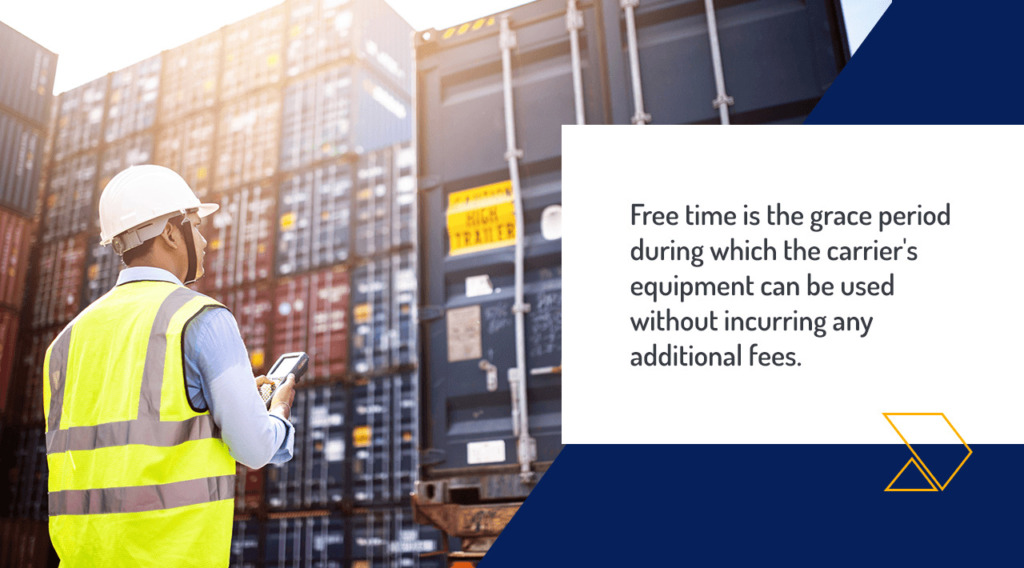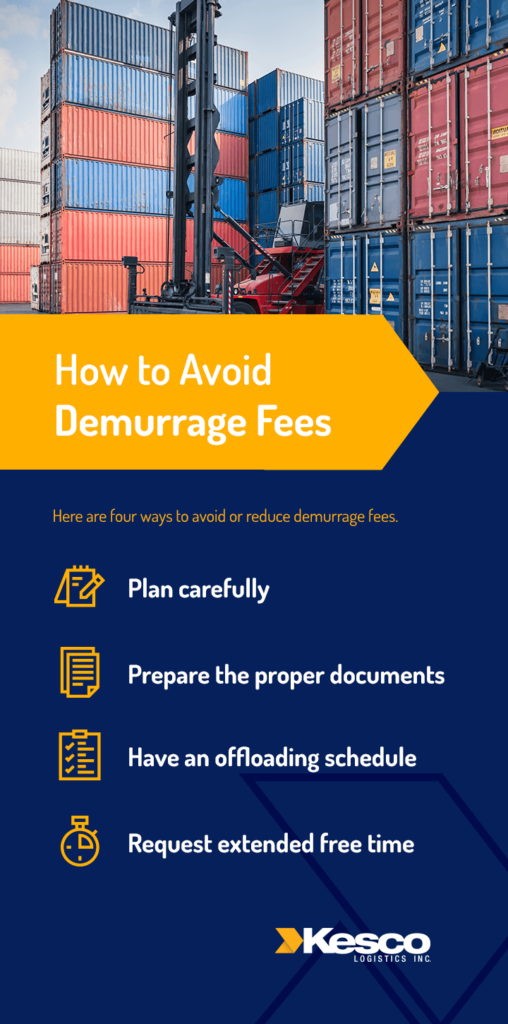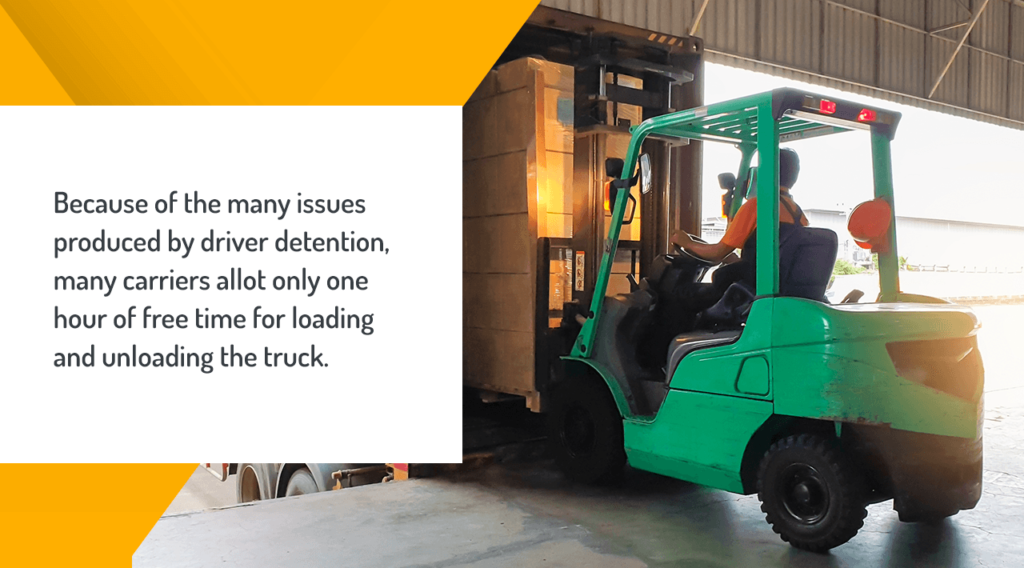What is free time? | What is demurrage? | How to Avoid Demurrage Fees | What is detention? | What is per diem? | What is driver detention? | How to Avoid Detention Fees | Managing Your Shipment
Every day, hundreds of cargo shipments are imported and exported to and from shipping ports. In order to accommodate all these shipments, ports run on strict timelines to maintain the flow of cargo, ensuring that each shipment has a place on the port. They do this by incentivizing shippers to work within their allotted timeline with fees.
Demurrage and detention fees can be expensive, and they accrue quickly. It is important to understand what these fees are and how to avoid them at the port. Understand your timeline from the port before your cargo arrives to ensure that you plan accordingly, not only at the port but also with the shipment’s receiver.

What is free time?
Free time is the grace period during which the carrier’s equipment can be used without incurring any additional fees. During the free time, the consignee must pick up the full container(s), unload it and return the empty container to the port. If they do not complete all of these steps within the designated free time, they risk fees from the shipping line.
The amount of free time varies depending on the port, so understand the contract agreement as you plan your shipment. Some ports use the time of arrival as the first day of free time. However, others may begin free time at the estimated time of arrival — as a result, if your shipment is delayed in arrival, you use your free time before it arrives at the port. The amount of free time also varies across ports, ranging anywhere from four to fourteen days.
A common phrase used in conjunction with free time is LFD, or “Last Free Day.” LFD refers to the last free day that a container can sit in the port after arriving before demurrage fees are incurred or the last free day for the container to be returned to the port after unloading before charging detention fees.
This grace period gives buffer room for issues that may arise at customs, problems with drayage or a lack of space in the factory at which the cargo will be stored. However, if you exceed the free days allowed by the port, then you risk accruing demurrage or detention fees — the more days you exceed, the larger the fee.
What is demurrage?
Demurrage fees are incurred when loaded containers remain at the port beyond the allotted free time. These fees are imposed by the shipping line to the sender.
For imports, shipping lines levy demurrage fees when the cargo recipient does not pick up the full container from the port within the free time after it has arrived. For exports, demurrage fees are levied when the exporter delivers a packed container to the port before the dispatch date.
The port is not a warehouse, and demurrage fees incentivize consignees and shippers to remove the containers from the port. Shipping lines must stick to tight schedules to maintain the consistent flow of containers. When containers are left at the port, they occupy valuable space needed for other shipments. Space and equipment turnover is essential to avoid port congestion and ensure supply chain efficiency.
Demurrage fees are determined and enforced by the shipping lines. The fees are levied per day per container, and costs vary across ports. The daily charge may increase the longer the container stays there. From the day free time expires until the container is removed from the port, charges are levied against the shipper. Once demurrage fees have been incurred, they must be paid before the container can be removed from the port.

How to Avoid Demurrage Fees
The best way to avoid demurrage fees is to understand what they are. With the proper preparation, you can minimize or avoid these fees altogether. Here are four ways to avoid or reduce demurrage fees.
1. Plan carefully.
Each shipping company determines its own free time allocation and fee rates. You should be aware of how much free time you have before it is too late. Understanding the port’s timeline for your cargo helps you plan more efficiently to arrange for the cargo’s pickup and processing in a timely manner.
Good plans account for some buffer time. Unexpected or unavoidable delays, such as poor weather conditions and a busy port, may impact the timeliness of your shipment. As you create your timeline for the shipment, remember to have a backup plan ready in the case of delays or issues along the way.
2. Prepare the proper documents.
Part of your careful plan should include all the documents you need to clear customs. Prepare your commercial invoice, bill of lading, packing list and arrival notice. By ensuring that you have the documents ready in advance, you minimize the chance that your shipment will be delayed. You can also clear your cargo through customs up to five days before the shipment arrives at the port.
Verify that the documents you submit are completed with the correct information. Incomplete or incorrect information on the documents, no matter how small, can prevent your cargo from reaching its destination on time.
Another aspect of documentation is ensuring that the payment has been processed. If your payment is delayed or not paid in full, then the shipment may be held until the payment has been fulfilled.
3. Have an offloading schedule.
Pre-clearing the cargo also gives more opportunities to coordinate loading with your trucker. Verify that a trucker will be available to pick up your shipment in a timely manner. Demurrage fees are easy to incur if there are no trucks or drivers available to move your shipment by the last free day, so coordinate with the freight forwarder to work with a trucking company with which they have a relationship.
It never hurts to have a backup plan for trucking, especially at busy ports or if your free time is very limited.
4. Request extended free time.
If you know that you will not be able to arrange for the container to be removed from the port within the free time, then you may be able to request extended free time during contract negotiations. Giving the shipping line a forewarning that you will be unable to comply with their free time period helps you establish a stronger timeline and helps them allocate the appropriate resources.
What is detention?
Detention fees are levied when a consignee has not returned a container to the port by the LFD. While demurrage fees are charged for keeping containers in the port too long, detention fees are incurred when the containers are outside of the terminal for too long. Detention fees can be charged regardless of whether the container is loaded or empty.
Some shipping lines will charge detention fees to use the equipment after the free time has expired, regardless of whether the container and equipment have left the port. This means that you can accrue demurrage and detention fees simultaneously if the container is left at the port beyond the free time for taking up space for other shipments and occupying equipment.
There are two kinds of detention fees — per diem and driver detention. Understanding the difference is essential for avoiding these unwanted charges.
What is per diem?
Per diem — meaning “per day” from Latin — is one type of detention fee with a fixed rate that is charged per container for each day that equipment is not returned to the port or container yard after the last free day. Like demurrage, shipping lines designate free time to return borrowed equipment. Detention and per diem are often used interchangeably because both refer to a fee that a shipping line charges daily as a result of delayed return of equipment.
For exports, the shipping line allots free time for the shipper to pick up the empty container, pack it and return it to the port. If the container is not returned by the LFD, then the shipping line begins charging per diem fees regardless of whether it is packed until the container is brought back to the port. For imports, consignees must pick up, unload and return the containers before the LFD to avoid per diem fees.
Per diem detention fees discourage shippers from storing containers for long periods of time. Storing containers stops the circulation of equipment that is essential for efficient workflow at the port. When containers sit at the port unused, they decrease the available resources for other shipments and either slow the workflow or force the carriers to purchase new equipment. Cargo carriers who own the equipment set and enforce their own detention fees.

What is driver detention?
Equipment is the primary reason for per diem detention fees. However, driver detention fees are charged when the truck is not loaded or unloaded within the designated free time. These fees are charged at an hourly rate to compensate for driver wait times.
Driver detention fees are charged for a variety of reasons, largely to allow for driver efficiency and safety. Delays cause drivers to lose legal driving hours — they are only permitted 11 driving hours per shift with required time off in between. These delays eat into the valuable time required for delivering the shipment.
Delays while loading or unloading also threaten late arrivals. When a driver misses or arrives past schedule, they may face fines or even being pulled out of service. Sticking to a strict schedule is essential for drivers to receive compensation for their work — driving detention fees ensure that they are compensated for their time.
Because of the high risk of arriving late, drivers tend not to drive as safely as they would have without a delay. KeepTruckin reported that 75% of drivers are detained for two or more hours every week. On average, drivers who are detained for at least two hours drive 3.5 mph faster than they do when they leave on time. These delays ultimately force drivers to try to complete their assignments in a smaller time frame, leading to higher risk on the road.
While drivers used to be able to adjust their paper logs to make up for time lost in detention, electronic logging devices (ELDs) monitor the driving activity. However, driver detention continues to delay drivers as they try to complete their shipments.
Because of the many issues produced by driver detention, many carriers allot only one hour of free time for loading and unloading the truck. This requires shippers to move quickly and plan efficiently to ensure that they do not incur any fees.
How to Avoid Detention Fees
Equipment shortages, poor weather conditions and busy ports can cause your shipment to be delayed and incur detention fees. Having a solid plan for your shipment helps you minimize the risk of easily avoidable issues causing these unnecessary fees.
1. Account for shipment capacity.
Large shipments may require more than one truck. When you coordinate with the trucking company, ensure that they have enough drivers and trucks to hold all of the cargo. If the trucking company does not have enough space for your whole shipment, you will have to scramble to find another way to transport the product. In especially busy ports, finding another truck and driver may be difficult because of the popular demand for the service.
2. Make sure the loading/unloading crew will be ready.
Confirm that the loading or unloading party is prepared to start moving when the shipment reaches the port. Moving the shipment in a timely manner ensures that you avoid detention fees. Your mindfulness of the driver will also not go unnoticed — when you prove that you respect their timeline and give them enough time to move your shipment, they will return the favor with high-quality services on the shipment and those thereafter.
3. Confirm your plan of delivery with the receiver.
When the receiver of the goods is unreachable, the shipment cannot be delivered. As a result, it is important to ensure that they know when to expect the shipment to arrive and have the unloading crew ready. If there are issues with the receiver, then using alternate storage options may be necessary to avoid detention fees.
4. Request an extension in advance.
As with ports and demurrage fees, you should know how much free time you have and when the clock starts ticking. If your shipment is large, it will take more time to load or unload. Maximizing your free time by confirming that the loading or unloading party will be ready is helpful, but even so, it may be necessary to request more time. If you know in advance that loading or unloading cannot be completed within the free time, negotiate the period with the trucking company in advance.
Managing Your Shipment
Whether you are a new business trying to navigate shipping for the first time or a veteran tired of the high prices and complications, Kesco Logistics can help facilitate a seamless shipment. Their extensive network of air, ocean and highway resources allows them to offer an easy, reliable shipment. They handle contract negotiations, creating a strong plan and making the process easy for you.
You can take advantage of their specialized services and years of experience in shipping apparel, furniture and electronics to ensure that your products reach their destination with minimal unnecessary demurrage and detention fees. You can send them a message on their website or call them directly at 516-341-7310 to make shipping easy!





